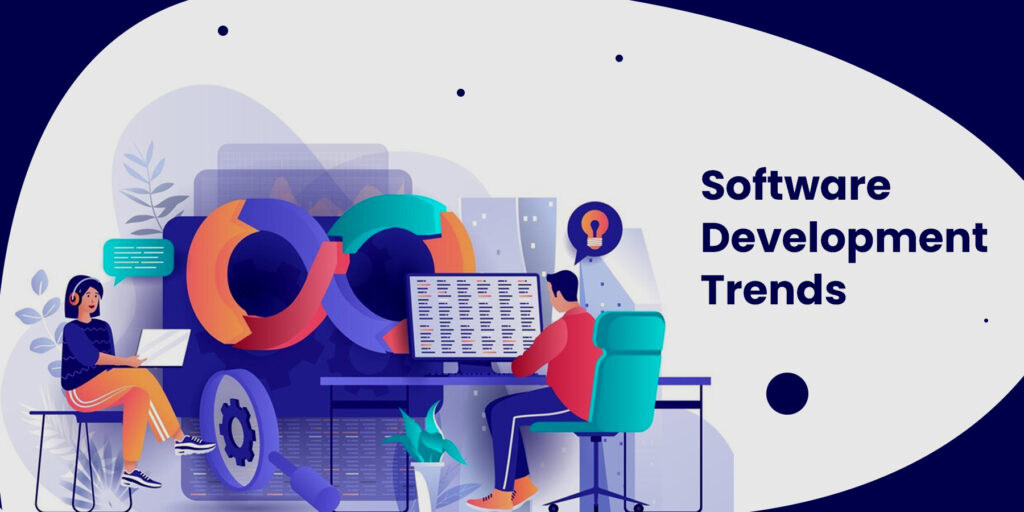Last updated on August 11th, 2025

Graphic design trends have come a long way since the first printing press. With the advent of digital media, designers have more tools than ever to create eye-catching and memorable designs. But what will the graphic design future look like in the next decade? Will the profession continue to evolve, or will it remain largely the same?
The field of graphic design has seen significant changes over the past decade, with the rise of social media and mobile devices creating new challenges and opportunities for designers. With technological change accelerating, it’s hard to know what the future holds for designers in this field.
To get a better sense of what’s in store for the future of graphic design, we spoke to a range of experts in the field. From new software tools to changing design trends, here are their predictions for what graphic design trends will look like in the next decade.
Table of Contents
Snapshot: Graphic Design Trends 2025
Vladimir Gendelman Is The Ceo And Founder Of Company Folders, Inc.
Traction’s Ceo And Co-Founder, Adam Kleinberg
Pj Richardson, Laundry’s Co-Owner And Creative Director
The Arizona Grand Resort’s Marketing Coordinator, Chelsey Moter
Miguel Lee, Midnight Sherpa’s Creative Director and Partner
Owner, Web Developer, And Graphic Designer At Logomazing Is Calvin Carter
Jake Smith, The Productviz Founder
How the Future of Digital Design is Transforming Roles
What the Graphic Design Industry Will Look Like in the 2030s
Frequently Asked Questions (FAQs)
Snapshot: Graphic Design Trends 2025
To understand the future of graphic design, it’s essential to examine what’s trending today. In 2025, we’re seeing a surge in hybrid aesthetics that blend 2D and 3D, dynamic typography, and AI-assisted design platforms. These aren’t just fleeting trends — they represent a larger shift toward personalization and responsiveness in digital spaces.
This year’s top graphic design trends include:
- Immersive scroll-based storytelling
- Generative design through AI
- Maximalist compositions and nostalgic textures
- Eco-conscious design driven by sustainability values
These trends hint at the broader changes in the graphic design industry and set the stage for what’s next.
According to Market Research Future, the global graphic design market is projected to reach $83.8 billion by 2032, up from $51.8 billion in 2022, growing at a CAGR of 4.8%.
Vladimir Gendelman Is The Ceo And Founder Of Company Folders, Inc.
By combining graphic design trends with augmented reality and, eventually, 3D printing, graphic design will reach new heights.
Through augmented and virtual reality, people can immerse themselves in an experience, whether for leisure, education, or employment. Designers will create worlds that people can enter. Likewise, augmented reality will enable designers to break free from their desks and create on the go or by incorporating more real-world elements.
Designers will be compelled by 3D printing to work more quickly and stay current on industry trends. The demand for high-quality designs will increase as more people access this technology, but expectations will rise more rapidly. ”.
Traction’s Ceo And Co-Founder, Adam Kleinberg
“Experience design and graphic design are in direct opposition to one another. Design is now more crucial than ever, even though print is almost completely dead as a form of expression. All designers will have to consider the context in the future when determining how users will interact with their work. There is a third dimension. ”.
Pj Richardson, Laundry’s Co-Owner And Creative Director
“In 10 to 15 years, a more significant gap will exist between technologically driven design and graphic nostalgia. Books, posters, and signage will still be around, but with novel new twists (imagine a Mars-like signage system).
A new kind of interactive-meets-motion graphics-meets-filmmaking approach to graphic design trends will be necessary for virtual reality, which will be fully functional via contact lenses or brain implants.
Economically, the sector will function like YouTube: commoditized, but with prominent influencers and experts who stand out and distinguish themselves about the current cultural interests. ”.
The Arizona Grand Resort’s Marketing Coordinator, Chelsey Moter
All businesses need graphic design, so it is essential. Graphic design is crucial in the digital world and the print world, where you need things like business cards, flyers, and postcards. Content is king, as most business owners and marketers are aware. The best content, however, tends to be far too wordy, and most readers will abandon an article if it is too long before they have even finished reading it.
Images, infographics, memes, quote cards, slideshows, and even videos are great tools for creating content that’s quicker and easier for users to understand. Regarding the future of graphic design, I believe that visual content will become more critical than traditional graphical design components, especially for artists. ”.
Miguel Lee, Midnight Sherpa’s Creative Director and Partner
“The way that we communicate through design will be influenced by technology more than ever. The paradigm in which we approach content creation is changing so frequently in the era in which we live that it has become the new standard.”
Specialized and highly technical methods of working inevitably devolve into simple “buttons,” enabling designers to realize their vision and create more prosperous and meaningful experiences without being constrained by technological limitations. High-end execution will continue to take place on a chessboard rather than in a battle of brute strength.
The design environment will become noisier due to this accessibility, placing a higher value on disruptive work to break through the noise. ”.
Owner, Web Developer, And Graphic Designer At Logomazing Is Calvin Carter
Over the next ten years, the future of graphic design will become more immersive. All designs will be digital with a website feel since paper will be unnecessary. These designs will need layers that enable the user to delve deeper into the design, ultimately selling the product without actually making a pitch.
The following graphic shows options for sunglasses that match the chosen outfit and how they appear on the user after the user first views the weather, which offers a bright, sunny day.
The need for every offshore graphic designer to be created in this layered format arises from the realization that graphic designers cannot simply say, “Buy these sunglasses.”. Future generations will be utterly useless because they will be oblivious to sexually explicit advertising. ”.
Jake Smith, The Productviz Founder
“The use of technology to develop engaging stories and concepts in graphic design will continue. As 3D, augmented reality, and virtual reality technology improves, designers will have more expressive means of communicating their ideas in the future.
Graphic design trends will become more dependent on computer-aided design due to this technology-focused strategy, moving them away from traditional tools and more into the virtual realm. Instead of generalist designers, this shift will be accompanied by more specialized professional experts.
How the Future of Digital Design is Transforming Roles
The future of digital design won’t just affect aesthetics — it’s redefining creative roles altogether. Designers are increasingly expected to be part strategist, part technologist. From UX mapping to motion design for AR interfaces, the skill set required is expanding rapidly.
As the graphic design future unfolds, we may witness:
- Greater collaboration with data scientists and coders
- The rise of graphic designers fluent in UI/UX platforms
- Demand for creative technologists with expertise in both storytelling and immersive media
This shift signals more than a tool change, it’s a complete overhaul in how creative value is defined.
What the Graphic Design Industry Will Look Like in the 2030s
As we approach a new creative era, here’s what graphic design in the future could encompass:
- Virtual Studios: Fully remote collaborative environments where designers co-create in real time
- AI + Human Hybrid Design Systems: AI offers options, but the human touch refines the final concept
- Hyper-Personalization: Designs adapt instantly to user behaviors and preferences
- Blockchain for Attribution: Immutable design authorship and royalties for creative works
These changes in graphic design industry standards are already beginning to take root, especially among tech-forward design agencies and digital-first brands.
Frequently Asked Questions (FAQs)
1. How has the graphic design industry changed?
The industry has evolved from static layouts to dynamic, user-centric experiences. Technological advancements, especially in AI and AR, have shifted the focus toward interactive and immersive designs.
2. What is happening in the graphic design industry?
The industry is experiencing rapid digital transformation. Trends like sustainable design, AI-generated assets, and motion-first branding are becoming mainstream, demanding designers stay agile and tech-savvy.
3. What is the future of the graphic design industry?
The future graphic design lies in human-AI collaboration, immersive storytelling, and cross-platform adaptability. Designers must embrace new tools, broaden their skills, and prioritize ethical, inclusive design practices to stay relevant.
Final Thoughts
The future of graphic design is expected to undergo significant changes and innovations in the next decade. From the increasing use of AI and machine learning to the evolution of design software and tools, designers must stay up-to-date with the latest trends and technologies to remain competitive in the industry. Additionally, the demand for sustainable and ethical design practices will continue to grow, and designers will need to prioritize inclusivity, accessibility, and social responsibility in their work.
As we look to the future of graphic design, it’s clear that the designer’s role will become even more essential in shaping the way we communicate and interact with the world around us. By embracing new technologies and incorporating ethical considerations into their work, designers can help create a better, more equitable future for all.
Need Designers Who Understand the Future of Graphic Design?
Work with pre-vetted creative professionals who specialize in motion, UI, AR/VR, and modern graphic design trends.
Suggested Reads:
- Are Async Video Interviews Costing You Top Talent? – Learn how asynchronous hiring tools might be turning away great candidates and what to use instead.
- How to Hire Remote Developers for Full-Cycle Product Development – Discover the best practices to find and manage remote tech talent across the entire development lifecycle.
- Top Hiring Tools for Creative Remote Recruitment in 2025 – A breakdown of the most effective and innovative hiring platforms for today’s remote-first hiring
David Bodiford
David Bodiford has been the Chief Strategy Officer at Vserve Ecommerce. Specializing in business development and strategic planning, David leads initiatives to expand Vserve Ecommerce's market reach, focusing mainly on the B2B sector. His expertise in digital marketing and strategic partnerships is integral to enhancing the agency's ecommerce solutions.

